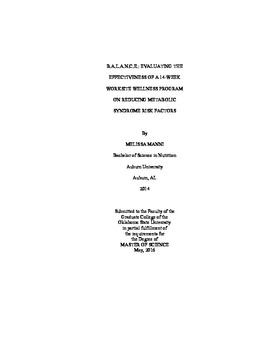| dc.description.abstract | The purpose of this study was to determine how successful the 14-week B.A.L.A.N.C.E. program was in reducing risk factors of metabolic syndrome, as well as determine if participants viewed this program as successful in helping them build a healthy lifestyle. A total of 89 Oklahoma State University benefits-eligible employees participated in the program between 2011-2014. Participants applied for the program through Oklahoma State University�s Department of Wellness and were accepted based on their level of risk for metabolic syndrome. All participants received three individual counseling sessions with a registered dietitian, attended at least ten nutrition education sessions, and had access a personal trainer for at least 60 minutes a week. After the 14-week intervention, participants were required to attend five monthly group meetings until the one-year mark. At week one, week 14 and one year follow-up, participants completed a health assessment that measured BMI, abdominal girth, cholesterol, triglycerides, HDL cholesterol, LDL cholesterol, systolic blood pressure, diastolic blood pressure, and blood glucose. Fitness (muscular strength, flexibility, VO2 Max) was assessed at baseline and week 14. Participants were invited to complete a perceptions survey after completion of the program; a total of 40 participants completed the survey. Paired t-tests showed significant reductions in BMI (p<0.001), girth (p<0.001), triglycerides (p<0.001), blood glucose (p=0.008), systolic blood pressure (p<0.001), diastolic blood pressure (p=0.015), flexibility (p<0.001), muscular strength (p<0.001), and VO2 Max (P<0.001) after 14 weeks. Paired t-tests did not show significant changes in HDL or total cholesterol. From baseline to one-year, paired t-test found significant reductions in BMI (p<0.001), girth (p<0.001), blood glucose (p=0.028), and systolic blood pressure (p=0.006). T-tests showed no significant differences in outcome measures between participants who fully complied with the program and those who did not. Most participants who completed the survey agreed or strongly agreed that participation in the program was beneficial and that they would recommend this program to other employees. Most participants agreed or strongly agreed that they understood more about nutrition and exercise after completing the program. Results from this program show a short-term worksite wellness program was effective in reducing metabolic syndrome risk factors, and that participants perceived the program as being beneficial to their health. | |
